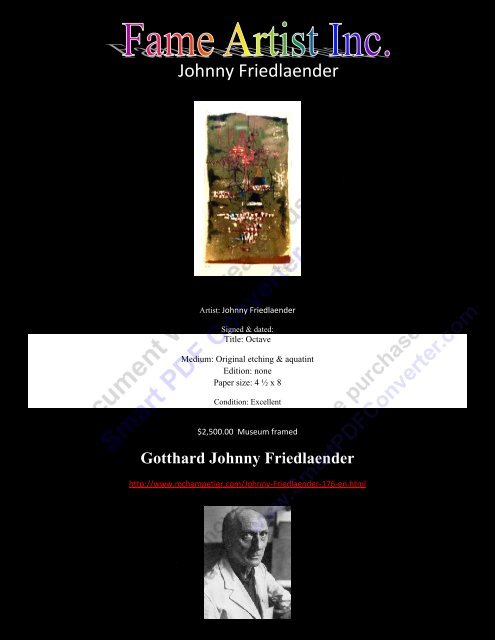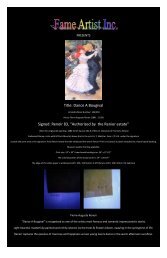Certificate Of Authe..
Certificate Of Authe..
Certificate Of Authe..
Create successful ePaper yourself
Turn your PDF publications into a flip-book with our unique Google optimized e-Paper software.
Johnny Friedlaender<br />
Artist: Johnny Friedlaender<br />
Signed & dated:<br />
Title: Octave<br />
Medium: Original etching & aquatint<br />
Edition: none<br />
Paper size: 4 ½ x 8<br />
Condition: Excellent<br />
$2,500.00 Museum framed<br />
Gotthard Johnny Friedlaender<br />
http://www.mchampetier.com/Johnny-Friedlaender-176-en.html
Was born in Pless (Pszczyna), Prussian Silesia, as the son of a pharmacist. He was graduated from the Breslau<br />
(Wrocław) high school in 1922 and then attended the Academy of Arts (Akademie der Bildenden Kunste) in<br />
Breslau, where he studied under Otto Mueller. He graduated from the Academy as a master student in 1928. In<br />
1930 he moved to Dresden where he held exhibitions at the J. Sandel Gallery and at the Dresden Art Museum.<br />
He was in Berlin for part of 1933, and then journeyed to Paris. After two years in a Nazi concentration camp, he<br />
emigrated to Czechoslovakia, where he settled in Ostrava, where he held the first one man show of his etchings.<br />
Re-entry to Paris<br />
In 1936 Friedlaender journeyed to Czechoslovakia, Switzerland, Austria, France and Belgium. At the Hague he<br />
held a successful exhibition of etchings and watercolours. He fled to Paris in 1937 as a political refugee of the<br />
Nazi regime with his young wife, who was an actress. In that year he held an exhibition of his etchings which<br />
included the works: L ‘Equipe and Matieres et Formes. From 1939 to 1943 he was interned in a series of<br />
concentration camps, but survived against poor odds.<br />
After freedom in 1944 Friedlaender began a series of twelve etchings entitled Images du Malheur with Sagile as<br />
his publisher. In the same year he received a commission to illustrate four books by Freres Tharaud of the<br />
French Academy. In 1945 he performed work for several newspapers including Cavalcade and Carrefour. In<br />
the year 1947 he produced the work Reves Cosmiques and in that same year he became a member of the Salon<br />
de Mai, which position he held until 1969. In the year 1948 he began a friendship with the painter Nicolas de<br />
Stael and held his first exhibition in Copenhagen at Galerie Birch. The following year he showed for the first<br />
time in Galerie La Hune in Paris. After living in Paris for 13 years, Friedlaender became a French citizen in<br />
1950.<br />
Friedlaender expanded his geographic scope in 1951 and exhibited in Tokyo in a modern art show. In the same<br />
year he was a participant in the XI Trienale in Milan, Italy. By 1953 he had produced works for a one man show<br />
at the Museum of Neuchâtel and exhibited at the Galerie Moers in Amsterdam, the II Camino Gallery in Rome,<br />
in São Paulo, Brazil and in Paris. He was a participant of the French Italian Art Conference in Turin, Italy that<br />
same year.<br />
International recognition<br />
Friedlaender accepted an international art award in 1957, becoming the recipient of the Biennial Kakamura<br />
Prize in Tokyo. In 1959 he received a teaching post awarded by UNESCO at the Museum of Modern Art in Rio<br />
de Janeiro. By 1968 Friedlaender was travelling to Puerto Rico, New York and Washington, D.C. to hold<br />
exhibitions. That year he also purchased a home in the Burgundy region of France. 1971 was another year of<br />
diverse international travel including shows in Bern, Milan, Paris, Krefeld and again New York. In the latter<br />
city he exhibited paintings at the Far Gallery, a venue becoming well known for its patronage of important<br />
twentieth century artists.<br />
From his atelier in Paris Friedlaender instructed younger artists who themselves went on to become noteworthy,<br />
among them Arthur Luiz Piza. Brigitte Coudrain. Rene Carcan, Andreas Nottebohm, Graciela Rodo Boulanger.<br />
Like Friedlaender, these students were expert in the lithographic and etching arts.<br />
1978 brought a retrospective of Friedlaender's works at the Musee d’Art Moderne de la Ville de Paris. He was<br />
awarded the Lovis Corinth Prize in Regensburg three years later. On his 75th birthday, Friedlaender was given a<br />
retrospective in the Bremen Art Museum. On his 80th birthday a retrospective exhibition was held in Bonn at<br />
the municipal council offices. Friedlaender died in Paris at the age of 79.<br />
Selected works<br />
� Enigme handsigned edition of 150 (1991)
� Jeux, handsigned edition of 150<br />
� Sonnette für Orpheus, handsigned edition of 135<br />
� Radierungen 1949-1989: Eine Auswahl, colour album published by Peerlings Gallery<br />
Bibliography<br />
� Rolf Schmücking, Friedländer: 100 Radierungen, Verlag Galerie Schmücking, Basel, 1983<br />
Further reading<br />
� Johnny Friedlaender: oeuvre, 1961-1965, Touchstone Publ., New York, 1967<br />
External links<br />
� Eine etwas ausführlichere Biografie des Künstlers<br />
� Galerie Birch in Copenhagen<br />
Biography from Rogallery.com:<br />
Please note: Artists not classified as American in our database may have limited biographical data compared to the<br />
extensive information about American artists.<br />
Johnny Friedlaender was a leading 20th century artist, whose works have been exhibited in Germany, France,<br />
Netherlands, Italy, Japan and the United States. He has been influential upon other notable artists, who were<br />
students in his Paris gallery. His preferred medium of aquatint etching is a technically difficult artistic process, of<br />
which Friedlaender has been a pioneer.<br />
Johnny Gotthard Friedlaender was born in Pless (Silesia) and his early studies were in Breslau under Otto Mueller. In<br />
1936 Friedlaender journeyed to Czechoslovakia, Switzerland, Austria, France and Belgium. At the Hague he held a<br />
successful exhibition of etchings and watercolours. He fled to Paris in 1937 as a political refugee of the Nazi regime<br />
with his young wife, who was an actress. In that year he held an exhibition of his etchings which included the works:<br />
L ‘Equipe and Matieres et Formes. From 1939 to 1943 he was interned in a series of concentration camps, but<br />
survived against poor odds.<br />
After freedom in 1944 Friedlaender began a series of twelve etchings entitled Images du Malheur with Sagile as his<br />
publisher. In the same year he received a commission to illustrate four books by Freres Tharaud of the French<br />
Academy. In 1945 he performed work for several newspapers including Cavalcade and Carrefour. In the year 1947,<br />
he produced the work Reves Cosmiques, and in that same year he became a member of the Salon de Mai, which<br />
position he held until 1969. In the year 1948 he began a friendship with the painter Nicolas de Stael and held his first<br />
exhibition in Copenhagen at Galerie Birch. The following year he showed for the first time in Galerie La Hune in Paris.<br />
After living in Paris for 13 years, Friedlaender became a French citizen in 1950.<br />
Friedlaender expanded his geographic scope in 1951, and exhibited in Tokyo in a modern art show. In the same year<br />
he was a participant in the XI Trienale in Milan, Italy. By 1953 he had produced works for a one-man show at the<br />
Museum of Neuchâtel and exhibited at the Galerie Moers in Amsterdam, the II Camino Gallery in Rome, in São Paulo,<br />
Brazil and in Paris. He was a participant of the French Italian Art Conference in Turin, Italy that same year.<br />
Friedlaender accepted an international art award in 1957, becoming the recipient of the Biennial Kakamura Prize in<br />
Tokyo. In 1959 he received a teaching post awarded by UNESCO at the Museum of Modern Art in Rio de Janeiro. By<br />
1968, Friedlaender was travelling to Puerto Rico, New York and Washington, D.C. to hold exhibitions. That year he<br />
also purchased a home in the Burgundy region of France. 1971 was another year of diverse international travel<br />
including shows in Bern, Milan, Paris, Krefeld and again New York. In the latter city he exhibited paintings at the Far<br />
Gallery, a venue becoming well known for its patronage of important twentieth century artists.<br />
From his atelier in Paris Friedlaender instructed younger artists who themselves went on to become noteworthy,<br />
among them Arthur Luiz Piza, Brigitte Coudrain, Rene Carcan, and Graciela Rodo Boulanger. Like Friedlaender, these<br />
students were expert in the lithographic* and etching arts.<br />
1978 brought a retrospective of Friedlaender's works at the Musee d’Art Moderne de la Ville de Paris. He was awarded<br />
the Lovis Corinth Prize in Regensburg three years later. On his 75th birthday, Friedlaender was given a retrospective<br />
in the Bremen Art Museum. On his 80th birthday he held a retrospective exhibition in Bonn at the municipal council
offices. Friedlaender died in Paris at the age of 89.<br />
Artworks in Museum Collections: (60)<br />
'I eschew coincidence in my work; it is not my master. I have made<br />
stringency my rule. I jot down my fleeting ideas in the form of<br />
numerous sketches and, as if for a musical score, they continue to be<br />
worked out.' (Quoted from: Friedlaender, Werkverzeichnis der<br />
Radierungen, Verlag Galerie Peerlings) Gotthard Johnny Friedlaender<br />
was born in Pless, Upper Silesia, on 21 June 1912, the son of an<br />
apothecary. After refugeeing from Pless to Breslau in 1921,<br />
Friedlaender attended higher secondary school leading to universityentrance<br />
qualification from 1922.<br />
Friedlaender enrolled at the Breslau Art Academy in 1928, where he<br />
attended the master classes taught by Otto Mueller, a member of 'Die<br />
Brücke'. Another teacher was Carlo Mense. Even during his academy<br />
years Johnny Friedlaender worked in lithography and etching. In 1930<br />
Friedlaender moved to Dresden, where his work was exhibited in<br />
group shows at Galerie J.Sandel. After the war years and moving<br />
from place to place,<br />
Friedlaender and his wife settled in Paris as political refugees in 1937,<br />
where Friedlaender showed his etchings at 'L'Équipe' and 'Matières et<br />
Formes', groups headed by Gaston Diehl. In 1938 and 1939<br />
Friedlaender worked at the literary weekly magazine 'Marianne' on<br />
Paul Chadourne's recommendation.<br />
The war made Friedlaender leave Paris but he returned in 1945. He<br />
worked for various journals and concentrated on etching as his main<br />
medium of expression but continued to do some watercolours. In<br />
1948 Friedlaender went to Denmark, where he had exhibitions,<br />
including one at the Birch Gallery in Copenhagen, which was followed<br />
by others.<br />
Friedlaender was one of the great inventors in coloured printmaking.<br />
A school formed in Paris round his work as a painter and printmaker<br />
and his coloured etchings were internationally aclaimed. In 1987 the<br />
Kunsthalle Bremen mounted a retrospective of Friedlaender's work
on the occasion of his seventy-fifth birthday. In 1992 Johnny<br />
Friedlaender died in Paris, where he had spent most of his adult life.<br />
Although he knew a difficult life, Friedlaender became<br />
one of the uncontested contemporary masters of the<br />
etching. His work went always in the heart of things and<br />
beings, his search was constantly poetic, leaving the<br />
freedom to his emotion and reinventing ceaselessly the<br />
power of suggestion. He studied to the Art Institute of<br />
Breslau (Germany)<br />
“Octive”<br />
For additional details,shipping,and your special price. Call or e-mail.



